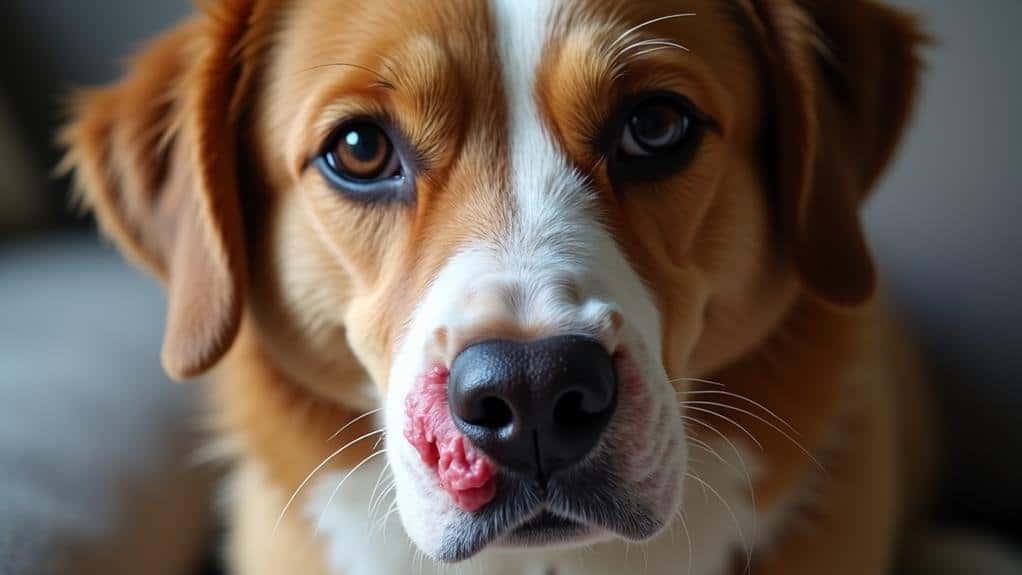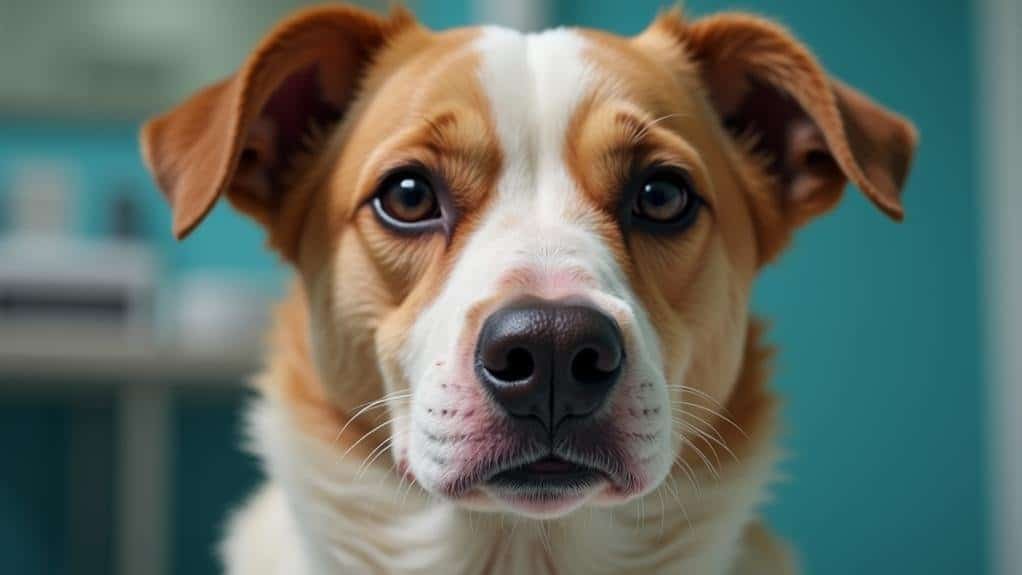Your dog’s face may be swollen on one side due to several reasons, including dental problems like abscesses, allergic reactions to insect bites or food, trauma from injuries, or tumors and cysts.
It’s essential to monitor your pet for signs of distress, such as difficulty breathing or eating, which could indicate an emergency.
If you notice any concerning symptoms, contact your veterinarian immediately.
They’ll perform a thorough examination and may recommend tests to determine the underlying cause.
Treatment options vary depending on the diagnosis, ranging from antibiotics to surgery.
Understanding potential causes and prevention strategies can help you better care for your furry friend.
Common Causes of One-Sided Swelling

Why might your dog’s face be swollen on just one side? There are several common causes for this facial swelling in dogs, each requiring different approaches to treatment.
Dental problems, particularly abscesses, can lead to localized swelling on one side of your dog’s face. These infections around tooth roots cause pain and inflammation.
Allergic reactions are another frequent cause of unilateral swelling. Your dog may have been stung by an insect or eaten something that triggered a reaction, often accompanied by itching or hives.
Trauma is a significant factor in one-sided facial swelling. If your dog has been in a fight, accident, or sustained an injury, you might notice localized swelling and signs of discomfort.
Tumors or growths, whether benign or malignant, can also cause asymmetric swelling and require prompt veterinary attention for proper diagnosis and treatment.
Less commonly, conditions like sialocele can result in one-sided swelling. This occurs when a salivary duct ruptures, causing saliva to accumulate in the surrounding tissue.
If you notice any unexplained swelling on your dog’s face, it’s essential to consult a veterinarian for an accurate diagnosis and appropriate treatment plan.
Dental Issues and Facial Swelling

Identifying dental issues is vital when your dog’s face swells on one side. Tooth abscesses are a common culprit, causing localized pain and inflammation as pus accumulates around the tooth root. If you notice one-sided facial swelling in your dog, it’s imperative to take dental problems into account as a potential cause.
Periodontal disease is another dental issue that can lead to facial swelling, particularly around the muzzle. This condition affects the gums and tooth roots, often accompanied by bad breath and difficulty eating. Your dog may show signs of discomfort, such as excessive drooling or reluctance to chew.
Early detection of dental problems is key to preventing complications that result in facial swelling. Regular dental check-ups can help catch issues before they escalate.
If you observe one-sided swelling, it’s essential to seek immediate vet attention, as this may indicate a serious dental infection requiring prompt treatment.
Your veterinarian may recommend interventions like tooth extraction or antibiotics to address the underlying cause of the swelling.
Allergic Reactions in Dogs
While dental issues are a common cause of facial swelling, allergic reactions can also lead to this symptom in dogs. If you notice your dog’s face swollen on one side, it could be due to an allergic reaction. These reactions can cause localized or generalized facial swelling, particularly around the muzzle and eyes, often appearing as hives or angioedema.
Allergic reactions in dogs can be triggered by various factors:
- Insect bites or stings
- Food allergies
- Environmental allergens like pollen or dust mites
Symptoms typically appear within minutes to hours after exposure to the allergen. In addition to facial swelling, your dog may experience itching, redness, and gastrointestinal upset.
It’s essential to monitor your pet closely, as severe allergic reactions can lead to life-threatening conditions like anaphylaxis.
If you suspect an allergic reaction, remove the possible cause if identifiable. For mild cases, antihistamines may help reduce swelling. However, if you notice difficulty breathing or other severe symptoms, seek immediate veterinary care.
Your vet may prescribe corticosteroids or administer epinephrine for more serious cases. Always consult a professional to determine the best course of action for your dog’s swollen face.
Trauma and Injury Consequences

Injuries can be a significant cause of facial swelling in dogs. If your pet has experienced trauma to the face, such as from a fall, bite, or collision, you may notice localized swelling on one side. This swelling can result from bruising, internal bleeding, or tissue damage.
It’s essential to seek immediate veterinary assessment following any injury. The swelling may indicate underlying fractures or serious soft tissue damage that isn’t immediately apparent. Your veterinarian can determine the extent of the injury and recommend appropriate treatment.
Be aware that swelling from trauma can develop over time as your dog’s body reacts to the injury. Watch for other symptoms like pain, difficulty eating or drinking, and behavioral changes. These signs can provide valuable information to your vet during the assessment.
Treatment for trauma-related facial swelling may include pain management, cold compresses, or surgical intervention if significant injuries are detected.
Tumors and Cysts
Tumors and cysts represent another important cause of facial swelling in dogs. If you notice unilateral swelling or asymmetry in your dog’s face, it could indicate the presence of a growth affecting facial tissues.
Both benign and malignant tumors can cause this swelling, as can cysts, which are fluid-filled sacs that develop under the skin.
It’s vital to distinguish between different types of growths:
- Benign tumors (e.g., lipomas): Soft, movable swelling
- Malignant tumors: Firm, fixed masses
- Cysts: Fluid-filled sacs that can mimic swelling
Early veterinary evaluation is essential when you suspect a tumor or cyst. Your vet will perform a thorough diagnosis to determine the nature of the growth and recommend appropriate treatment.
Remember, timely intervention can greatly impact treatment outcomes and your dog’s quality of life.
Keep a close eye on any facial growths you notice. Monitor for changes in size or appearance, as rapid growth or alterations may indicate malignancy or complications.
If you observe any concerning changes, don’t hesitate to seek prompt veterinary care. Your vigilance can make a notable difference in your dog’s health and well-being.
Identifying Emergency Situations
Vigilance is key when it comes to your dog’s facial swelling. If you notice your dog’s face is swollen on one side, it may indicate an allergic reaction that could potentially obstruct their airways. This is an emergency situation requiring immediate veterinary care.
Don’t ignore a lopsided appearance, as it might suggest serious conditions like dental abscesses or tumors that need urgent evaluation.
Pay close attention to your dog’s eating and drinking habits. If they’re refusing food or water alongside facial swelling, it could point to painful dental issues that demand prompt attention.
Watch for changes in gum color, particularly if they turn purple or blue, as this signals a severe allergic reaction or shock.
Other symptoms that warrant an emergency visit to the vet include difficulty breathing, excessive drooling, or lethargy when combined with facial swelling.
Veterinary Diagnosis and Treatment

When you bring your dog to the vet for facial swelling, they’ll typically start with a thorough physical examination. This helps assess the extent and specific characteristics of the swelling.
Your vet may then perform diagnostic tests like blood work, imaging, or skin scrapings to identify underlying causes such as infections, allergies, or tumors.
Based on the diagnosis, your vet will develop a tailored treatment plan. For dental-related swelling, they might recommend:
- Dental cleanings
- Tooth extractions
- Antibiotics to manage infections
If allergic reactions are the culprit, your vet may prescribe antihistamines or corticosteroids. In severe cases involving respiratory distress, emergency interventions might be necessary.
Throughout the treatment process, follow-up appointments are essential. These allow your vet to monitor your dog’s recovery and adjust the treatment plan as needed.
Prevention and Home Care Tips

Prevention is key when it comes to managing your dog’s facial swelling. Start by establishing a consistent dental care routine, including daily brushing and regular veterinary cleanings. This helps prevent dental problems that can lead to swelling of the jaw or face.
Keep a close eye on your dog’s face and mouth, regularly inspecting for signs of redness, unusual growths, or swelling.
Identify and avoid potential allergens that could trigger facial swelling in your dog. Consult your vet for allergy testing if you suspect sensitivities to certain foods, plants, or insects.
When outdoors, monitor your dog closely to prevent traumatic injuries from other animals or accidents that might cause facial swelling.
Educate yourself on breed-specific health issues that could contribute to facial swelling. This knowledge will help you recognize early symptoms and seek prompt veterinary care.
Frequently Asked Questions
What to Do if One Side of My Dog’s Face Is Swollen?
If one side of your dog’s face is swollen, take them to a vet immediately. Apply a cold compress while waiting. Watch for breathing issues or behavioral changes. Provide your vet with detailed information about recent incidents or diet changes.
What Can I Give My Dog to Reduce Swelling in the Face?
You can give your dog antihistamines for mild reactions, but consult your vet first. They might prescribe corticosteroids for severe cases. Apply cold compresses for immediate relief. Never give medication without identifying the cause and getting professional advice.
How Long Does It Take for Swelling to Go Down in a Dog’s Face?
The time for your dog’s facial swelling to subside varies greatly. It can take hours to days for allergic reactions, up to a week for infections, and longer for trauma. Seek vet care if it persists beyond 48 hours.
Will Benadryl Help My Dog’s Swollen Face?
Benadryl can help your dog’s swollen face if it’s caused by a mild allergic reaction. You’ll need to give 1 mg per pound of your dog’s weight. However, always consult your vet before administering any medication.
Conclusion
You’ve learned about various causes of one-sided facial swelling in dogs, from dental issues to allergic reactions.
Remember, it’s essential to monitor your pet closely and seek veterinary care if you’re concerned.
Don’t try to diagnose the problem yourself; a professional can provide the best treatment.
By staying vigilant and providing proper care, you’ll help guarantee your furry friend stays healthy and comfortable.
Keep an eye out for warning signs and act promptly when needed.

